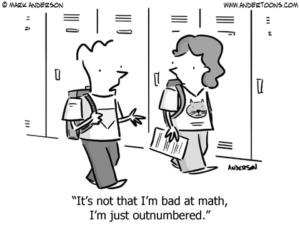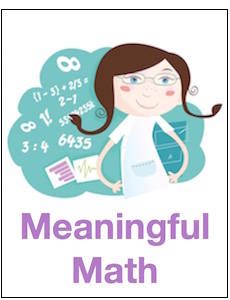Starting the Year by Calming Math Qualms
A MiddleWeb Blog
 New Year, New Me?
New Year, New Me?
Another beginning of the school year is in the books for me! This starts year 17. My first year teaching I couldn’t wait to get some experience so that the start of the year would be easier. I thought that, once I had something that worked, I could do it every year.
What I didn’t know then was this: It doesn’t get easier, ever. That’s not a bad thing, it’s just reality. Every single year I have taught has been different – every first day of school has been different.
It seems like each year things are more and more hectic around the first day of school, and I never have enough time. So what I did this year for beginning of year activities required minimal prep by necessity.
Also, this year we had a pretty specific procedure for the first day of school, so I didn’t have as many “first day” activities as I have had in previous years, but I wanted to share some of my experiences from the first weeks of school.
Multiplication Tables
We did this the second day of school, and the students actually liked it (I have mostly 11th graders). I think for them it was something of a novelty. I shared a link from Mr. Nussbaum Learning + Fun to practice their multiplication tables and gave them about ten minutes to refresh their memories while I was taking care of all the things that have to be handled the first day: attendance, lockers, helping students look up their passwords, etc.
At the end of the ten minutes, we talked a little bit about their experience with timed multiplication tests. It’s crazy how many students have horror stories. I’m not saying I’m against timed multiplication tests; I just know that some students have anxiety around them, and I have found it’s better to talk about it up front.
We discussed why it’s so helpful to know your math facts automatically, and we also talked about why some students have trouble remembering their facts. I shared some strategies to use when that’s the case (keeping a times table handy, having a calculator, etc.).
Then I gave them a sheet with 100 multiplication facts on it and set the timer for 5 minutes, and they did as many as they could. They didn’t receive a grade for it, but it helped ease them back into mathematics and to see what facts they needed to brush up on.
After the timer when off, students started sharing with other students some strategies for remembering certain facts. I took the sheets up so I could put them in their folders. When we do another drill, I’ll share them out so they can see how they have improved.
Desmos
I have talked about Desmos before, and in my opinion, it just keeps getting better and better. Every year there are more resources available on Desmos. We started the year off by using the activity Polygraph: Parabolas. The students are paired with someone in the room. One student picks a certain parabola among a screen of parabolas, and the student they are paired with tries to guess which parabola they chose by asking yes or no questions.
Since this is an introductory activity, students don’t know the vocabulary associated with parabolas yet, and it makes for interesting questions. After the activity you can talk about how much easier it would be if we knew what to call parts of the parabola, and this leads nicely into the first lesson on parabolas.
It’s also fun to let students play again after they know the correct vocabulary and see how much quicker it is to guess the right parabola. My students had a very favorable response to this activity.
Basketball Goals and Coloring Books
This might seem pretty random, but these are two things I started this year, and it seems to be something my students like. I hung a basketball goal (just a small toy sized one) in the back of my room. When students are done working and have put their supplies away with a minute or so before the bell rings, they will go back there and throw a foam ball. Sometimes I will join them, and we will throw the ball for a little bit. It’s been a really good way to talk with my students and get to know them.
I have also put coloring books and crayons in the back of my room. In recent years my students have been experiencing more and more stress and anxiety. I have the coloring books available so students can grab them if they need to calm down or de-stress a little. Some of students color almost every day in our advisory period.
Polaroid
This is the only activity that I do every year. My new students have heard about it and actually ask me about it. I take an Instant picture of my students (if they want, if not no big deal). Students get a kick out of watching them develop. I hang the pictures behind my desk and then when students graduate, I put them in their graduation card as a memento.
Making Students Feel at Ease

I told them it was important to me to make them feel comfortable and safe in my classroom. (I also told them that they would have to be willing to work with everyone in the class from time to time).
For teenagers, being able to sit next to someone they know can put them at ease. After class I had a student tell me that it meant a lot that I said I wanted them to feel comfortable and not stressed out. I was really surprised that it registered at all, but it made me determined to work harder to make students feel relaxed and ready to “do math” in my classroom.
I am reaslly excited for this school year. There are so many things I want to try in my classroom and so many ways I want to improve. I hope everyone has a great year!
Feature image by Isabella Fischer on Unsplash































